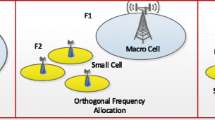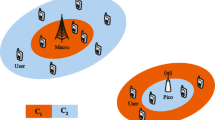Abstract
Network densification via small cell deployments can enhance the network capacity in a cost-effective manner. Co-tier and cross-tier interferences form barriers to boost the network performance. In this paper, an interference coordination scheme with the aid of cognitive radio is proposed for dense small cell networks. Based on the theory of stochastic geometry, the network spectral efficiency is derived as a function of the radius of exclusion zone. Furthermore, the optimal radius of exclusion zone that maximizes system spectral efficiency is obtained by one-dimension searching. Simulation results show that the proposed interference coordination scheme with the optimal exclusion zone outperforms the existing ones in terms of system spectral efficiency.






Similar content being viewed by others
References
Bhushan, N., Li, J., Malladi, D., et al. (2014). Network densification: The dominant theme for wireless evolution into 5G. IEEE Communications Magazine, 52(2), 82–89.
Kamel, M., Hamouda, W., & Youssef, A. (2016). Ultra-dense networks: A survey. IEEE Communications Surveys and Tutorials, 18(4), 2522–2545.
Wang, H., Song, R., & Leung, S.-H. (2015). Analysis of uplink intercarrier interference in OFDMA femtocell networks. IEEE Transactions on Vehicular Technology, 64(3), 998–1013.
Soret, B., Pedersen, K. I., Jorgensen, N. T. K., et al. (2015). Interference coordination for dense wireless networks. IEEE Communications Magazine, 53(1), 102–109.
Zahir, T., Arshad, K., & Nakata, A. (2013). Interference management in femtocells. IEEE Communications Surveys and Tutorials, 15(1), 293–311.
Xu, Y., Zhang, Y., Q. Wu, et al. (2016). Dynamic spectrum access for cognitive small cell networks: A robust graphical game approach. In IEEE/CIC international conference on communications in China (ICCC) (pp. 1–6).
Yan, Z., Zhou, W., Chen, S., & Liu, H. (2017). Modeling and analysis of two-tier HetNets with cognitive small cells. IEEE Access, 5, 2904–2912.
Zhang, H., Nie, Y., Cheng, J., et al. (2017). Sensing time optimization and power control for energy efficient cognitive small cell with imperfect hybrid spectrum sensing. IEEE Transactions on Wireless Communications, 16(2), 730–743.
Mukherjee, S. (2014). Analytical modeling of heterogeneous cellular networks. Cambridge: Cambridge University Press.
Wang, Y., & Zhu, Q. (2017). Modeling and analysis of small cells based on clustered stochastic geometry. IEEE Communications Letters, 21(3), 576–579.
Andrews, J. G., Gupta, A. K., & Dhillon, H. S . (2016) . A primer on cellular network analysis using stochastic geometry. ArXiv Preprint ArXiv:1604.03183.
Saha, C., Afshang, M., & Dhillon, H. S. (2017). Enriched \(K\)-tier HetNet nodel to enable the analysis of user-centric small cell deployments. IEEE Transactions on Wireless Communications, 16(3), 1593–1608.
Meerja, K.A., Ho, P.H., & Wu, B. (2011). A novel approach for co-channel interference mitigation in femtocell networks. In IEEE global telecommunications conference (GLOBECOM) (pp. 1–6).
Cheng, S. M., Ao, W. C., Tseng, F. M., & Chen, K. C. (2012). Design and analysis of downlink spectrum sharing in two-tier cognitive femto networks. IEEE Transactions on Vehicular Technology, 61(5), 2194–2207.
Bao, W., & Liang, B. (2015). Stochastic analysis of uplink interference in two-tier femtocell networks: Open versus closed access. IEEE Transactions on Wireless Communications, 14(11), 6200–6215.
Wang, H., Song, R., & Leung, S. H. (2016). Optimal uplink access in cognitive femtocell networks with adaptive modulation. IEEE Communications Letters, 20(5), 1050–1053.
ElSawy, H., & Hossain, E. (2014). Two-tier HetNets with cognitive femtocells: Downlink performance modeling and analysis in a multichannel environment. IEEE Transactions on Mobile Computing, 13(3), 649–663.
Haenggi, M., & Ganti, R. K. (2009). Interference in large wireless networks. Breda: Now Publishers Inc.
Zeinalpour-Yazdi, Z., & Jalali, S. (2014). Outage analysis of uplink two-tier networks. IEEE Transactions on Communications, 62(9), 3351–3362.
Kingman, J. F. C. (1993). Poisson process. Oxford: Oxford University Press.
Chiu, S. N., Stoyan, D., Kendall, W. S., & Mecke, J. (2013). Stochastic geometry and its applications (Vol. 3rd edition). New York: Wiley.
Gradshteyn, I. S., & Ryzhik, I. M. (2007). Table of intergrals, series and products (7th ed.). San Diego, CA: Academic.
3GPP TR 36.814. (2010). 3rd generation partnership project; Technical specification group radioaccess network; Further advancements for E-UTRA physical layer aspects (Release 9), V9.0.0.
Acknowledgements
This work was supported in part by Natural Science Foundation of China (61801246), by China Postdoc Innovation Talent Supporting Program (BX20180143), by Natural Science Foundation of Jiangsu Province (BK20170910), by Natural Science Foundation of Jiangsu Higher Education Institutions (16KJB510035), and by Open Research Fund of Jiangsu Engineering Research Center of Communication and Network Technology, NUPT.
Author information
Authors and Affiliations
Corresponding author
Ethics declarations
Conflict of interest
The author declared no potential conflicts of interest with respect to the research, authorship, and/or publication of this article.
Additional information
Publisher's Note
Springer Nature remains neutral with regard to jurisdictional claims in published maps and institutional affiliations.
Rights and permissions
About this article
Cite this article
Wang, H. Optimal Radius of Exclusion Zone for Dense Cognitive Small Cell Networks. Wireless Pers Commun 103, 2977–2993 (2018). https://doi.org/10.1007/s11277-018-5988-7
Published:
Issue Date:
DOI: https://doi.org/10.1007/s11277-018-5988-7




